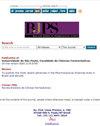传统上最不为人所知的药用强效草药紫荆的生物活性评价Betsche
IF 0.9
4区 医学
Q4 PHARMACOLOGY & PHARMACY
引用次数: 0
摘要
本文章由计算机程序翻译,如有差异,请以英文原文为准。
Bioactivity evaluation of least explored traditionally acclaimed medicinally potent herb Nanorrhinum ramosissimum(Wall.) Betsche
the therapeutic potential of traditionally acclaimed medicinal herb Nanorrhinum ramosissimum , using plant parts extracted with different solvents (10 mg/mL). Shoot extracts exhibited comparatively better antimicrobial properties, in comparison to root extracts. Total phenolic content was estimated, to ascertain its dependency on antioxidant properties of plant extracts. Antioxidant assay revealed promising results in comparison to IC 50 value of standard ascorbic acid (52.2±0.07 µg/mL), for methanolic extracts of shoot (61.07±0.53 µg/mL and 64.33±0.33 µg/mL) and root (76.705±0.12 µg/mL and 89.73±0.28 µg/ mL) for in vivo and in vitro regenerants respectively. Correlation coefficient R 2 values ranged between 0.90-0.95, indicating a positive correlation between phenolic contents and antioxidant activity. Plant extracts were also able to inhibit DNA oxidative damage again indicating their antioxidative potential. Antidiabetic potential was confirmed by alpha amylase inhibition assay where shoot methanolic extracts ( invivo , in vitro ) exhibited the best IC 50 values (54.42±0.16 µg/ mL, 66.09±0.12 µg/mL) in comparison to standard metformin (41.92±0.08 µg/mL). Ethanolic extracts of roots ( in vitro, invivo ) exhibited the relative IC 50 values (88.97±0.32µg/mL,96.63±0.44 µg/mL) indicating that shoot parts had a better alpha amylase inhibition property; thus proving the herb’s bioactive potential and its prospective therapeutic source for curing various ailments.
求助全文
通过发布文献求助,成功后即可免费获取论文全文。
去求助
来源期刊

Brazilian Journal of Pharmaceutical Sciences
PHARMACOLOGY & PHARMACY-
CiteScore
1.40
自引率
0.00%
发文量
165
审稿时长
7.5 months
期刊介绍:
The Brazilian Journal of Pharmaceutical Sciences accepts for publication Original Papers applicable to the fields of Pharmaceutical Sciences; Reviews and Current Comment Articles, which are published under the Scientific Editor and Associate Editors invitation to recognized experts or when they are spontaneously submitted by the authors in the form of abstracts to have their importance evaluated. A critical view of the subject with insertions of results of previous works in the field in relation to the state of art must be included; Short Communications reporting new methods and previews of works on researches of outstanding importance in which originality justify a quick publication. A maximum of 2000 words excluding tables, figures and references is an acceptable limit. One table, one figure and ten references may be added, and Book Reviews of the latest editions of books, prepared by specialists invited by the Scientific Editor and Associate Editors. Thematic Supplements as well as those related to scientific meetings can be published under the Scientific Editor and/or Associate Editors agreement.
 求助内容:
求助内容: 应助结果提醒方式:
应助结果提醒方式:


